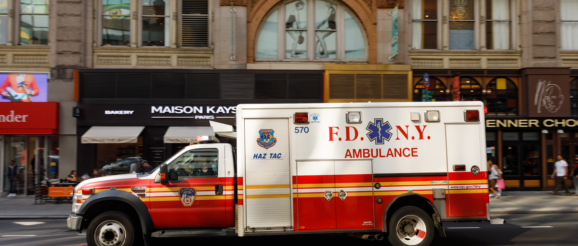N.Y. HIEs Making Progress on Connecting EMS Providers to Hospitals | Healthcare Innovation

Health information exchange organizations in New York are beginning to play a role in connecting emergency medical services (EMS) providers and hospital emergency rooms. In New York City, Healthix has begun connecting EMS agencies to hospitals, starting with 17 small independent EMS agencies and the Fire Department of New York.
In New York City there are about 100 EMS agencies and more than 80 hospitals. If every EMS agency had to connect directly to every hospital, it would require thousands of connections. Instead, EMS agencies will send Healthix patient data in the form of electronic pre-hospital care reports (ePCRs) and it will, in real-time, send that information on to the 81 hospitals already connected to Healthix. The HIE said this will result in hospital ERs getting better information about patients, even before they arrive and provide a more comprehensive view of the patient’s history. Initially, Healthix is connecting 17 EMS facilities with the Mount Sinai Health System, and connecting FDNY with NYC Health & Hospitals.
Once the service is standardized, the program will be rolled out to the rest of the hospitals and EMS agencies in the region. At first, the patient data will flow in one direction: from the EMS, through Healthix, to the hospital. In the future, data about pre-existing conditions and medications will flow from Healthix to the EMS responder in the field. That way, Healthix can tell the EMT key patient information that they would not otherwise know such as a positive COVID-19 test or a medication allergy, while they are in the field with the patient.
In Rochester, N.Y., the Rochester RHIO announced last December that two EMS providers are now contributing patient data to Rochester RHIO, which will enhance individualized care and has the potential to improve social services support, the RHIO said. Monroe Ambulance and Finger Lakes Ambulance are the first to participate in a new grant program with Rochester RHIO, which serves as the on-ramp for the SHIN-NY (Statewide Health Information Network for New York) across the 14-county Greater Finger Lakes Region.
Both ambulance services benefitted from the Data Exchange Incentive Program (DEIP), an initiative of the New York State Department of Health with support from the Centers for Medicare & Medicaid Services. DEIP is now providing financial grants to help offset costs for EMS providers and pharmacies to connect to qualified entities such as the Rochester RHIO— expenses typically incurred for specialized software and related information technology services. Previously, DEIP was employed to successfully increase SHIN-NY connections by long-term care facilities, behavioral health organizations and diagnostic treatment centers.
HIEs in other states are making progress, too. In 2019, Manifest MedEx in California was selected by the Emergency Medical Services Authority (EMSA) for $4.9 million in grant funding to develop and implement an interoperable health information exchange between emergency ambulance service providers and hospitals. The goal was to work with six local EMS agencies, 13 EMS providers, and 16 hospitals to cover eight counties (Riverside, San Bernardino, Fresno, Tulare, San Joaquin, Merced, Amador, Stanislaus, Calaveras) and more than 7.6 million Californians
In Colorado, EMS agencies can query the CORHIO HIE’s PatientCare 360 web portal for data from hospitals and labs. They also have access to Direct messaging with other providers. The CORHIO web site features this quote from Rick Lewis, EMS Bureau Chief of the South Metro Fire Department: “In the pre-hospital world, every time you want follow up, you have to talk to a coordinator, ask them to research and send everything that happened with patient X. With CORHIO, it’s instant — you go in and see the details right away. Now that we have CORHIO, we follow up all the time — it allows us to make more subtle changes in the way our department runs emergency calls.”
